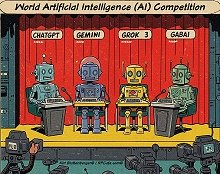Electronics & Technology
- See Full List of AI Topics -
 Kirchhoff's Voltage Law (aka
Kirchhoff's 2nd Law) is one of the fundamental principles in electrical
circuit theory. It's named after Gustav Kirchhoff, a German physicist who formulated
this law in the mid-19th century. KVL is used to analyze and describe the behavior
of voltage in closed electrical circuits. Kirchhoff's Voltage Law (aka
Kirchhoff's 2nd Law) is one of the fundamental principles in electrical
circuit theory. It's named after Gustav Kirchhoff, a German physicist who formulated
this law in the mid-19th century. KVL is used to analyze and describe the behavior
of voltage in closed electrical circuits.
The statement of Kirchhoff's Voltage Law is as follows:
"In any closed loop or mesh within an electrical circuit, the sum of the voltage
rises is equal to the sum of the voltage drops."
In other words, when you traverse a closed loop in a circuit and take into account
all the voltage sources (voltage rises) and voltage-consuming elements (voltage
drops) encountered along the way, the algebraic sum of these voltage changes is
always zero. This is based on the conservation of energy, which states that energy
cannot be created or destroyed but only transferred or transformed. In an electrical
circuit, the voltage changes account for the energy transfer, and KVL ensures that
no energy is lost or gained within a closed loop.
Mathematically, Kirchhoff's Voltage Law can be expressed as:
Σ (voltage rises) = Σ (voltage drops)
 This content was generated by primarily
the ChatGPT (OpenAI), and/or
Gemini (Google), and/or
Arya (GabAI), and/or
Grok (x.AI), and/or DeepSeek artificial intelligence (AI) engine.
Some review was performed to help detect and correct any inaccuracies; however,
you are encouraged to verify the information yourself if it will be used for critical
applications. In some cases, multiple solicitations to the AI engine(s) was(were) used to assimilate
final content. Images and external hyperlinks have also been added occasionally.
Courts have ruled that AI-generated content is not subject to copyright restrictions,
but since I modify them, everything here is protected by RF Cafe copyright. Many
of the images are likewise generated and modified. Your use of this data implies
an agreement to hold totally harmless Kirt Blattenberger, RF Cafe, and any and all
of its assigns. Thank you. Here are the major categories. This content was generated by primarily
the ChatGPT (OpenAI), and/or
Gemini (Google), and/or
Arya (GabAI), and/or
Grok (x.AI), and/or DeepSeek artificial intelligence (AI) engine.
Some review was performed to help detect and correct any inaccuracies; however,
you are encouraged to verify the information yourself if it will be used for critical
applications. In some cases, multiple solicitations to the AI engine(s) was(were) used to assimilate
final content. Images and external hyperlinks have also been added occasionally.
Courts have ruled that AI-generated content is not subject to copyright restrictions,
but since I modify them, everything here is protected by RF Cafe copyright. Many
of the images are likewise generated and modified. Your use of this data implies
an agreement to hold totally harmless Kirt Blattenberger, RF Cafe, and any and all
of its assigns. Thank you. Here are the major categories.
Electronics & High Tech
Companies | Electronics &
Tech Publications | Electronics &
Tech Pioneers | Electronics &
Tech Principles |
Tech Standards Groups &
Industry Associations | Societal
Influences on Technology
|








